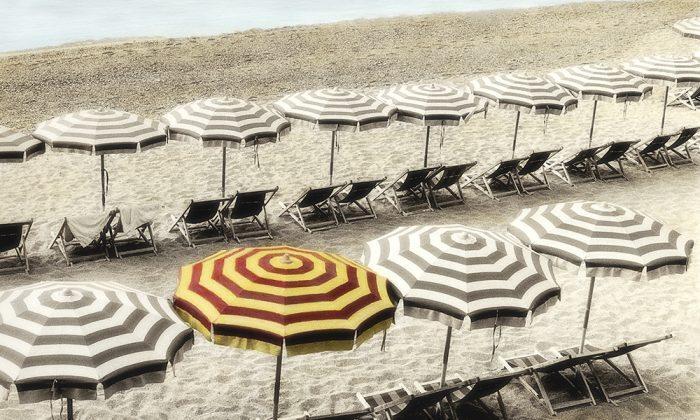This is part 8 of a 9-part series. To see the full series, see At The Confluence
The increasing prevalence of photography has fundamentally changed the way representational art is created and perceived in the modern day. At the Confluence examines how some of today’s artists have responded to the shift.
Hand-colored photographs are something of a lesser-known hybrid of the realist art world. First, a photograph is taken, either digitally or on film, and then it is printed from a computer or developed in a darkroom. Photoshop or some photochemical magic can be applied at this point to create effects on the image. Finally, the resultant photograph is worked over in specially developed oil paints, pan pastels, or inks.

Is it photography? Is it painting? Depends on how you define those terms. If you consider the act of translating a 3-D reality onto a 2-D surface by way of human faculties, then no, it’s not painting. If you think it’s painting because it involves actual paint, then yes. Generally, though, hand coloring is best thought of as photography-plus.
Intro to Hand Coloring
“Alternative photographic techniques” is a catch-all term to describe a variety of processes that can be done to a photographic print. These include bromoil, hand coloring, hand tinting, and toning photographs.
These techniques have roots in the early days of photography and were used to enhance photo portraits. Specifically, photo oils were developed to add a flush to the cheek, smoothness to hair, or to minimize the appearance of blemishes. With the advent of color photography, the need for hand coloring diminished, and it evolved into an art form.
Today, hand-colored photography is practiced by a small number of enthusiasts around the world, mainly women.
I spoke with Dianne Poinski of Sacramento, California, and Terri Sprinkle of Atlanta, Georgia. Both are accomplished photo colorists with no formal training in realist painting. Poinski and Sprinkle took up the art form as a creative outlet from accounting studies and health care management, respectively. Poinski switched from film to digital photography in 2007; Sprinkle works exclusively from film images.

Back before the Great Recession of 2008, Poinski used to show her work on the art festival circuit.
“Some people would assume it was done in Photoshop, others thought it was painting, and I would correct them. Later I even showed photos of myself at work to prove it,” Poinski said. “A main job of any artist is to educate her audience.”
Poinski has been a photographer for 20 years who resisted digital for a long time, finally getting her first digital camera in 2007 when her film and paper of choice were discontinued.

Today, her process begins with taking color photos of simple subjects like flowers and landscapes, which lend themselves well to hand coloring. Then she turns them black and white on the computer, making value adjustments as needed. (For hand coloring, the initial image needs to be lighter than desired.) As soon as she touches pigment to paper, she no longer refers back to the original color version.
“With hand coloring, you can change a sky to sunset. You can change colors according to what the client wants,” she said. “So I try not to look at the original color photo. I am not interested in duplicating what was originally there.”
In this sense, though the nature of photography dictates a certain degree of realism, a hand colorist can dress the skeleton of a black and white image with whatever color mood she imagines, or felt at the time the photo was taken.
The Art of It
Poinski said she can’t paint or draw to save her life. Nor does her art require life drawing skills—the camera takes care of most of that.
Behind the camera, the artist must think about composing a pleasing image with an eye for light and dark. At the easel, she must then engage her knowledge of color theory. As a hand colorist, one should know something about cool and warm colors, and the effect they have on the realism of a scene.
Poinski took some color theory classes but found that it complicated her intuitive understanding of color. She finds nature to be a much better teacher.
“When I first started hand coloring, my grass was green, that was it,” Poinski said. “But then as I did it more, I started looking at grass, and I noticed the yellows, the blues, the pinks in it. When I added the different colors, I found that it adds depth. I arrived at that by looking at life.”
Two Degrees of Manipulation
For Terri Sprinkle, the journey began one day when her photographer husband threw her into the deep end. She'd been assisting him on wedding and event shoots, but one day he handed her a high-speed black-and-white camera and told her to shoot candids.

“‘Just don’t point it at open windows. I will explain later,’” Sprinkle recalls him instructing. She learned about the problem of backlit photos later, but as it turned out, some of those candid photos weren’t bad. “He was impressed, and I was ecstatic.”
Her immediate love for photography spurred her to spend several months in adult art classes learning hand coloring.
Today, Sprinkle is known to stroll the streets of Atlanta with two or three cameras strapped around her neck. If she comes across an interesting subject, she may capture it once with her black-and-white 35mm film camera, and again with a Holga toy camera. The Holga has a plastic lens that creates a natural vignette and a surreal mood.

Sprinkle’s darkroom technique of choice allows her an additional opportunity to get creative. Using the bromoil process, she develops multiple versions of her negatives. Bromoil was developed in the mid-19th century and involves bleaching and tanning a silver-gelatin print to burn away the image. Then lithographic ink is applied, resulting in an image reminiscent of an oil or charcoal sketch.
“Pixels give a plastic-y, tight, perfect look,” Sprinkle said. “That’s wonderful but it’s not for me. I like a grainy look. With bromoil, you can scrape it, beat it, whip it, whatever.”
Mechanical Meets Manual
Though Poinski works in digital and Sprinkle in film, both agree that alternative photographic techniques have a strong appeal to physicality.

“I love a hands-on experience with my work,” Poinski said. “I can also create something in Photoshop that looks good and spit out a print, but hand coloring produces something that’s unique and original, something you can’t duplicate. That’s very satisfying.”
With the proliferation of cameraphones, professional photographers are finding it harder to make a place for themselves in this tidal flood of cheap images. Hand coloring and other alternative photographic techniques, though they aren’t necessarily new methods, may be a way for photographers to set themselves apart.
“There aren’t as many people doing hand coloring as there used to be, but there’s going to be a backlash with technology,” she said. “It wouldn’t surprise me to see it go full circle. We as a society will want more handcrafted.”
Two thousand miles away from Sacramento, Sprinkle feels similarly.
“I prefer to work with my hands away from a computer. I don’t want to move pixels. I want to move ink or oil or slosh chemicals,” she said. “As humans, we have a need to express the world around us. Film and alternative processes allow us to do that in a way the digital process has limits on.”
Tweet @EpochArts with your thoughts on the series using the hashtag #confluence.
Terri Sprinkle’s Influences
Gene Laughter
“A bromoil artist, now retired. Laughter (rhymes with ‘daughter’) has been inspirational to me, not only for his mastery of this technique, but for his friendly, open manner of instruction. He is one of those artists who does not believe in withholding any so-called secrets of the trade when he interacts with students and other artists. I’ve not met him in person, but had the pleasure of chatting online with him a few times, and he was never less than encouraging and gracious over my fumbling early attempts with this process.”
Jill Enfield
“A fine-art photographer who specializes in alternative photographic processes. In particular, her hand-colored black and white prints are exquisitely done, and I have admired her work for many years. Her articles and books on hand coloring, as well as other alternative processes, helped me along tremendously.”
Sally Mann
“For me, she is the quintessential photographer’s photographer, for her artistic vision as well as her talent. She shoots with an 8-by-10 large format camera, is a masterful darkroom printer, and has also put out a large body of work using the collodion (wet plate) process. She seems fearless in her explorations, whatever her current project may be. I admire her versatility as a photographer and as a writer.”
Technique Talk With Dianne Poinski
During the recession, adults were flocking back to school to expand their skills. During that time, Poinski taught hand coloring classes out of her studio. Here, she talks about the key techniques for hand coloring photographs.
I have a lot of respect for watercolor artists. That medium is unforgiving. With photo oils, as long as you got to it before it dried, you can start over.
Then there’s pan pastels. With them, it’s easier to add pigment that subtract, so adding too much color initially is the easiest way to screw up. Pastels are also more opaque than photo oils, so it’s also easy to lose detail. But in the worst case scenario, you can always make another print.
The most important thing in hand coloring are the materials. I spent a whole year testing materials—papers, pigments, applicators, and brushes in various permutations. I even razored sticks of pastels into powder before I learned of pan pastels. After all that experimentation, when I was teaching, a student said that my materials list itself was “worth the admission.”








Friends Read Free